The XEDS detectors market is growing at USD 84.6 million in 2025 and forecasted to reach USD 186.1 million by 2035, advancing at a CAGR of 8.2%. Inflection point mapping highlights the phases where growth dynamics shift significantly. From 2020 to 2025, revenue grows from USD 57.1 million to USD 84.6 million, representing the first inflection point, where adoption broadens beyond early research labs into mainstream academic and industrial applications. Demand is mainly driven by materials science, nanotechnology studies, and growing use in semiconductor analysis, establishing the baseline for higher adoption.
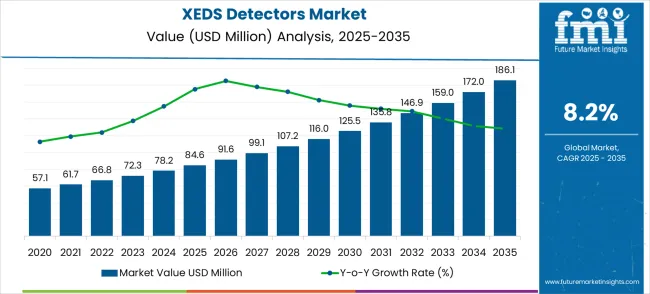
| Metric | Value |
|---|---|
| Market Value (2025) | USD 84.6 million |
| Market Forecast Value (2035) | USD 186.1 million |
| Market Forecast CAGR | 8.2% |
Between 2025 and 2030, the market expands from USD 84.6 million to USD 125.5 million, marking the second inflection point. Growth accelerates as XEDS detectors see wider use in advanced electron microscopy, metallurgy, and electronics quality control. This period demonstrates increased integration with automated systems and higher-resolution analytical platforms, reflecting both replacement demand and expansion into emerging economies. The mapping here highlights the transition from selective adoption toward more standardized usage across industries where material characterization is essential.
From 2030 to 2035, revenue increases from USD 125.5 million to USD 186.1 million, signaling the third inflection point, where adoption matures and the market stabilizes into a higher penetration phase. Growth during this period is supported by repeat purchases, upgrades to higher-performance systems, and the rising importance of precision analytical tools in biotechnology and energy materials research. Inflection mapping indicates that by 2035, the market is moving toward maturity, with demand increasingly tied to replacement cycles and incremental enhancements rather than breakthrough adoption, while still sustaining strong growth momentum through continuous reliance on XEDS technology in high-value research and industrial sectors.
Market expansion is being supported by the continuous increase in materials research activities worldwide and the corresponding need for advanced analytical instruments that provide superior elemental analysis capabilities and detection precision for critical research and quality control applications. Modern research institutions and industrial laboratories rely on consistent analytical performance and high-resolution detection to ensure optimal materials characterization, including composition analysis, phase identification, and the detection of contaminants. Even minor detection inaccuracies can necessitate adjustments to comprehensive analytical procedures to maintain optimal research standards and data reliability.
The growing complexity of nanomaterials research and the increasing demand for non-destructive analytical techniques are driving the demand for XEDS detectors from established manufacturers with the appropriate detection capabilities and analytical expertise. Research teams are increasingly requiring documented detection sensitivity and analytical precision standards to maintain research quality and publication standards. Scientific frameworks and analytical standards are establishing standardized spectroscopy procedures that require specialized X-ray detection technologies and trained analytical personnel.
The XEDS detectors market is entering a sustained growth phase, driven by demand for advanced analytics, the expansion of materials research, and evolving analytical precision and automation standards. By 2035, these pathways together can unlock USD 50-65 million in incremental revenue opportunities beyond baseline growth.
Pathway A -- Technology Leadership (Silicon Drift Detectors) The SDD segment already holds the largest share due to its superior performance and convenience. Expanding resolution capabilities, count rate optimization, and integration features can consolidate leadership. Opportunity pool: USD 15-20 million.
Pathway B -- Research Applications Expansion (Materials Sciences) Materials sciences account for the largest demand. Growing nanotechnology research and advanced materials development, especially in emerging economies, will drive higher adoption of analytical detectors for characterization applications. Opportunity pool: USD 12-16 million.
Pathway C -- Industrial Market Development (Quality Control Applications): Industrial applications represent significant growth potential due to increasing quality control automation. Detectors optimized for production environments can capture substantial growth. Opportunity pool: USD 10-13 million.
Pathway D -- Emerging Market Expansion, Asia-Pacific and Latin America present growing demand due to research infrastructure development. Targeting cost-effective solutions and educational partnerships will accelerate the adoption of these initiatives. Opportunity pool: USD 8-11 million.
Pathway E -- Next-Generation Technology Integration. With increasing analytical sophistication, there is an opportunity to promote advanced detector technologies with enhanced capabilities and automation. Opportunity pool: USD 6-8 million.
Pathway F -- Specialized Applications (Advanced Research) Detectors optimized for synchrotron applications, in-situ analysis, and specialized research environments offer premium positioning for high-end markets. Opportunity pool: USD 4-6 million.
Pathway G -- Service & Support Revenue Recurring revenue from calibration services, technical support, and detector maintenance creates long-term engagement streams. Opportunity pool: USD 2-4 million.
Pathway H -- Digital Integration & Smart Analytics Automated analysis software, cloud connectivity, and AI-powered interpretation can elevate detectors into comprehensive analytical solutions. Opportunity pool: USD 1-2 million.
The market is segmented by detector type, application, and region. By detector type, the market is divided into Silicon Drift Detector (SDD), Silicon Lithium Detector (Si(Li)), and other detection technologies. Based on application, the market is categorized into materials sciences and industrial applications. Regionally, the market is divided into North America, Europe, East Asia, South Asia & Pacific, Latin America, and Middle East & Africa.
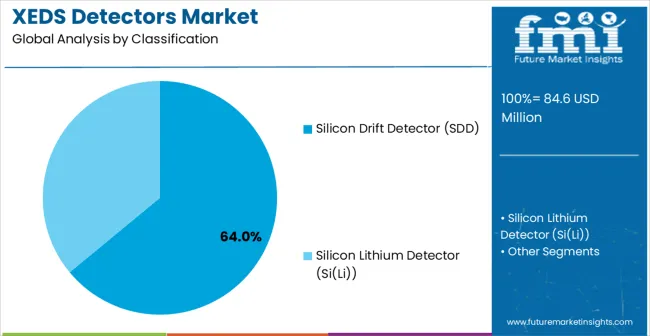
In 2025, the Silicon Drift Detector (SDD) segment is projected to capture around 64% of the total market share, making it the leading detector type category. This dominance is largely driven by the widespread adoption of solid-state detection technology that provides optimal balance between detection efficiency and energy resolution, catering to a wide variety of analytical and research applications. SDD detectors are particularly favored for their ability to deliver superior count rates and temperature stability in both electron microscopy and X-ray spectroscopy installations, ensuring analytical precision and operational reliability. Research institutions, analytical laboratories, quality control facilities, and materials characterization applications increasingly prefer this technology, as it meets demanding analytical requirements without imposing excessive cooling system complexity or maintenance overhead.
The availability of well-established manufacturing processes, along with comprehensive technical support and standardized integration protocols from leading suppliers, further reinforces the segment's market position. Additionally, this detector type category benefits from consistent performance across diverse analytical conditions, as it is considered a versatile and reliable solution for applications requiring high-throughput elemental analysis and precise spectroscopic measurements. The combination of detection performance, operational convenience, and system integration flexibility makes SDD detectors a practical choice, ensuring their continued dominance in the analytical instrumentation and research markets.
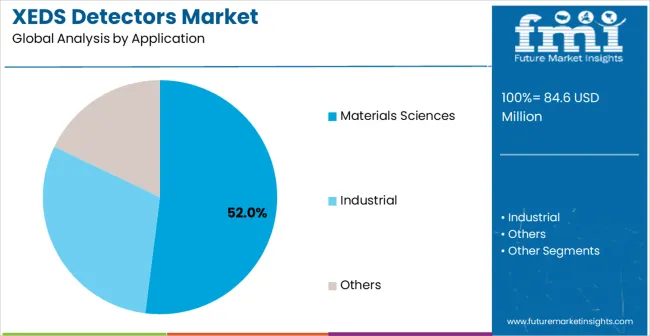
The materials sciences segment is expected to represent 52% of XEDS detectors demand in 2025, highlighting its position as the most significant application sector. This dominance stems from the critical analytical requirements of modern materials research, where elemental composition analysis and microstructural characterization are essential to materials development and scientific understanding. Materials science laboratories often feature extensive analytical workflows that demand specialized X-ray detectors throughout complex research projects, requiring precise and reliable elemental identification solutions. XEDS detectors are particularly well-suited to these environments due to their ability to provide consistent multi-element analysis and high spatial resolution, even during detailed characterization studies and varying sample conditions. As materials research becomes more sophisticated globally and emphasizes improved analytical accuracy standards, the demand for advanced X-ray detection systems continues to rise.
The segment also benefits from heightened research requirements within academic and industrial materials science, where researchers are increasingly prioritizing analytical precision and detection sensitivity as essential research tools. With materials science programs investing in advanced characterization techniques and nanotechnology research capabilities, XEDS detectors provide an essential instrument to maintain high-performance analytical standards and research productivity. The growth of nanomaterials research and advanced materials development, coupled with increased focus on multi-scale characterization, ensures that materials sciences will remain the largest and most stable demand driver for XEDS detectors in the forecast period.
The XEDS Detectors market is advancing steadily due to increasing research and development investments and growing recognition of X-ray spectroscopy advantages over traditional analytical techniques in materials characterization applications. However, the market faces challenges including higher costs compared to basic analytical instruments, need for specialized technical expertise and system integration capabilities, and complex calibration requirements with varying analytical protocols across different research applications. Innovation efforts and advanced detector technology programs continue to influence instrument development and market adoption patterns.
The growing development of advanced silicon detector technologies and enhanced energy resolution systems is enabling superior analytical precision with improved peak separation and reduced spectral interference. Advanced detector applications and optimized electronics systems provide superior elemental identification while maintaining high throughput requirements. These technologies are particularly valuable for research institutions that require precise analytical capabilities supporting extensive materials characterization operations with consistent high-resolution results.
Modern XEDS detector manufacturers are incorporating advanced digital processing capabilities and intelligent analysis systems that enhance analytical efficiency and data quality. Integration of automated peak identification algorithms and optimized spectrum processing systems enables superior analytical productivity and comprehensive elemental quantification capabilities. Advanced digital features support operation in diverse research environments while meeting various analytical requirements and data quality specifications.
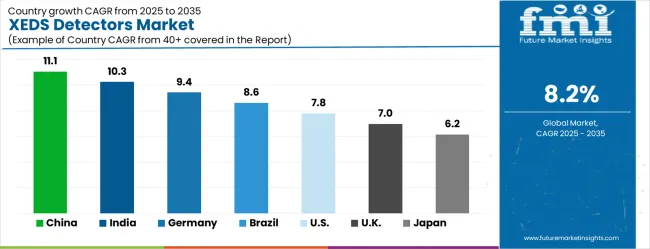
| Country | CAGR (2025-2035) |
|---|---|
| China | 11.1% |
| India | 10.3% |
| Germany | 9.4% |
| Brazil | 8.6% |
| United States | 7.8% |
| United Kingdom | 7.0% |
| Japan | 6.2% |
The XEDS detectors market is growing consistently, with China leading at an 11.1% CAGR through 2035, driven by the expansion of research infrastructure and the increasing adoption of advanced analytical instrumentation solutions. India follows at 10.3%, supported by growing investment in materials research and the increasing implementation of sophisticated characterization technologies.
Germany grows strongly at 9.4%, integrating advanced detector technology into its established research and industrial infrastructure. Brazil records an 8.6% increase, emphasizing research infrastructure development and initiatives to enhance analytical capabilities. The United States is showing solid growth at 7.8%, with a focus on advanced research applications and innovations in detector technology. The United Kingdom demonstrates steady progress at 7.0%, maintaining established research applications. Japan records 6.2% growth, focusing on technological advancement and optimizing analytical precision.
The report covers an in-depth analysis of 40+ countries top-performing countries are highlighted below.
XEDS detectors in China is projected to exhibit the highest growth rate with a CAGR of 11.1% through 2035, driven by unprecedented research infrastructure expansion and increasing demand for advanced analytical instrumentation solutions. The country's massive research and development sector and expanding university research facilities are creating enormous demand for sophisticated detector solutions. Major research institutions are establishing comprehensive analytical capabilities to support the increasing requirements of materials science programs and industrial research centers across metropolitan research zones.
Government science and technology development initiatives are supporting establishment of world-class research facilities and advanced analytical instrument complexes, driving demand for high-performance X-ray detectors throughout major research corridors. Research infrastructure modernization programs are facilitating the adoption of detector technologies that enhance analytical capabilities and research productivity standards across academic and industrial research networks.
XEDS detectors in India is expanding at a CAGR of 10.3%, supported by increasing materials research investment and growing implementation of advanced analytical technologies. The country's expanding research sector and rising analytical capabilities are driving demand for sophisticated detector solutions. Research institutions and analytical laboratories are gradually implementing high-performance detection systems to maintain competitive standards and research quality.
Materials research sector growth and analytical infrastructure development are creating opportunities for suppliers that can support diverse analytical requirements and cost-effective specifications. Professional training and technical programs are building expertise among research personnel, enabling effective utilization of detector technology that meets analytical standards and research requirements.
XEDS detectors in Germany is projected to grow at a CAGR of 9.4%, supported by the country's emphasis on research quality standards and advanced analytical technology adoption. German research institutions and industrial laboratories are implementing sophisticated detection systems that meet stringent performance requirements and analytical specifications. The market is characterized by focus on analytical precision, instrument reliability, and compliance with comprehensive research standards.
Research industry investments are prioritizing cutting-edge detector technology that demonstrates superior performance and reliability while meeting German quality and analytical standards. Professional certification programs ensure comprehensive technical expertise among research personnel, enabling specialized analytical capabilities that support diverse research applications and scientific requirements.
XEDS detectors market in Brazil is growing at a CAGR of 8.6%, driven by increasing research infrastructure development and growing recognition of advanced analytical technology advantages. The country's expanding research sector is gradually integrating sophisticated detector solutions to enhance analytical capabilities and research competitiveness. Research institutions and industrial laboratories are investing in detector technology to address evolving analytical requirements and international standards.
Research infrastructure modernization is facilitating adoption of advanced detector technologies that support comprehensive analytical capabilities across research regions. Professional development programs are enhancing technical capabilities among research personnel, enabling effective detector utilization that meets evolving analytical standards and performance requirements.
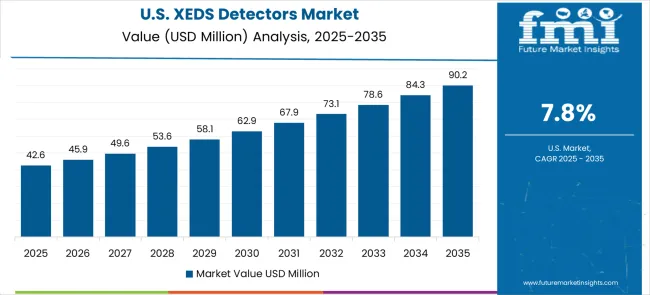
XEDS detectors market in the USA is expanding at a CAGR of 7.8%, driven by established research industries and growing emphasis on advanced analytical capabilities. Large research institutions and analytical service providers are implementing comprehensive detector capabilities to serve diverse analytical requirements. The market benefits from established research infrastructure, distribution systems, and professional development programs that support various materials research and industrial applications.
Research industry leadership is enabling standardized detector utilization across multiple facility types, providing consistent performance standards and comprehensive analytical coverage throughout regional markets. Professional development and certification programs are building specialized technical expertise among research personnel, enabling effective detector utilization that supports evolving research and analytical requirements.
XEDS detectors market in the UK is projected to grow at a CAGR of 7.0%, supported by established research sectors and growing emphasis on analytical precision capabilities. British research institutions and analytical service providers are implementing detector systems that meet industry performance standards and research requirements. The market benefits from established research infrastructure and comprehensive training programs for scientific professionals.
Research facility investments are prioritizing advanced detector solutions that support diverse analytical applications while maintaining established performance and quality standards. Professional development programs are building technical expertise among research personnel, enabling specialized detector operation capabilities that meet evolving facility requirements and analytical standards.
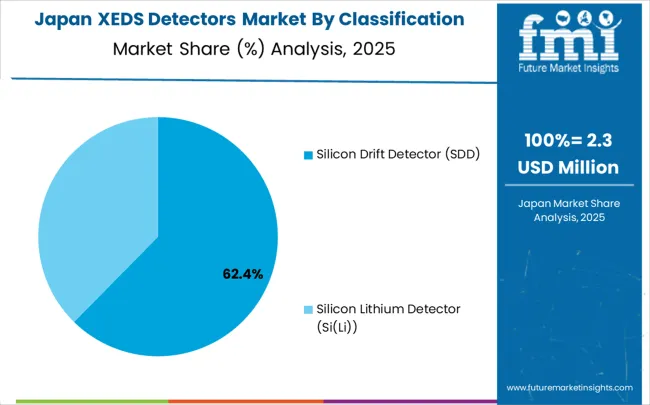
Revenue from XEDS detectors in Japan is growing at a CAGR of 6.2%, driven by the country's focus on analytical technology innovation and precision instrumentation applications. Japanese research institutions and technology companies are implementing advanced detector systems that demonstrate superior performance reliability and analytical consistency. The market is characterized by emphasis on technological excellence, analytical precision, and integration with established research workflows.
Analytical technology investments are prioritizing innovative detector solutions that combine advanced sensing technology with precision electronics while maintaining Japanese quality and reliability standards. Professional development programs ensure comprehensive technical expertise among research personnel, enabling specialized analytical capabilities that support diverse research applications and precision requirements.
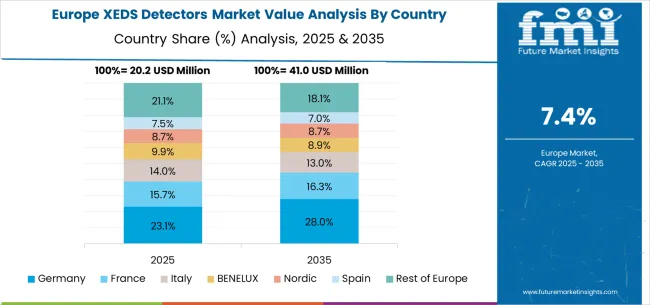
The XEDS detectors market in Europe is forecast to expand from USD 22.1 million in 2025 to USD 48.6 million by 2035, registering a CAGR of 8.2%. Germany will remain the largest market, holding a 30.7% share in 2025, easing to 30.2% by 2035, supported by strong research infrastructure and advanced analytical adoption standards. The United Kingdom follows, rising from 22.8% in 2025 to 23.2% by 2035, driven by research facility modernization and enhancements to analytical capabilities. France is expected to maintain stability, with a rate of 17.9% to 17.6%, reflecting consistent research industry investments and detector requirements. Italy is expected to hold around 12.6% of the market throughout the forecast period, supported by research facility upgrades and analytical system modernization programs. Spain's growth rate increases from 9.1% to 9.4% with the expansion of research infrastructure and an increased focus on advanced analytical solutions. BENELUX markets maintain 4.6% to 4.4%, while the remainder of Europe hovers near 2.3%--2.6%, balancing emerging Eastern European research development against mature Nordic markets with established detector technology adoption patterns.
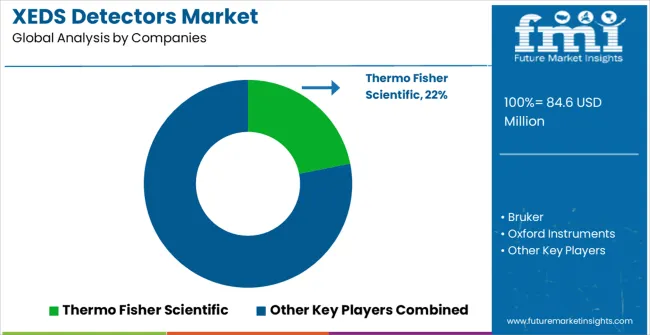
The XEDS Detectors market is defined by competition among specialized analytical instrument manufacturers, X-ray technology companies, and scientific equipment solution providers. Companies are investing in advanced detector technology development, signal processing innovation, sensitivity enhancement, and comprehensive technical support capabilities to deliver precise, reliable, and user-friendly analytical detection solutions. Strategic partnerships, technological innovation, and market expansion are central to strengthening product portfolios and market presence.
Thermo Fisher Scientific offers comprehensive analytical instrumentation solutions with established global expertise and professional-grade detection capabilities. Bruker provides specialized analytical systems with focus on research applications and high-performance detection. Oxford Instruments delivers advanced X-ray technology with emphasis on precision optimization and research-friendly integration. Ametek EDAX specializes in electron beam microanalysis with advanced detector integration capabilities.
JEOL offers professional-grade analytical equipment with comprehensive electron microscopy compatibility. Hitachi High-Technologies delivers established analytical platforms with advanced detection technologies. Ketek provides specialized X-ray detectors with a focus on performance optimization. RaySpec, PNDetector, and Mirion Technologies offer specialized detector expertise, analytical reliability, and comprehensive development across global and regional analytical instrumentation market segments.
| Item | Value |
|---|---|
| Quantitative Units | USD 84.6 million |
| Detector Type | Silicon Drift Detector (SDD), Silicon Lithium Detector (Si(Li)) |
| Application | Materials Sciences, Industrial, and Others |
| Regions Covered | North America, Europe, East Asia, South Asia & Pacific, Latin America, Middle East & Africa |
| Country Covered | China, India, Germany, Brazil, United States, United Kingdom, Japan, and 40+ countries |
| Key Companies Profiled | Thermo Fisher Scientific, Bruker, Oxford Instruments, Ametek EDAX, JEOL, Hitachi High-Technologies, Ketek, RaySpec, PNDetector, Mirion Technologies |
| Additional Attributes | Dollar sales by detector type and application segment, regional demand trends across major markets, competitive landscape with established analytical instrument manufacturers and emerging detector providers, customer preferences for different detector configurations and performance options, integration with electron microscopy and X-ray systems protocols, innovations in detector technology and sensitivity efficiency, and adoption of advanced digital features with enhanced analytical capabilities for improved research workflows. |
The global XEDS detectors market is estimated to be valued at USD 84.6 million in 2025.
The market size for the XEDS detectors market is projected to reach USD 186.1 million by 2035.
The XEDS detectors market is expected to grow at a 8.2% CAGR between 2025 and 2035.
The key product types in XEDS detectors market are silicon drift detector (sdd) and silicon lithium detector (si(li)).
In terms of application, materials sciences segment to command 52.0% share in the XEDS detectors market in 2025.






Our Research Products

The "Full Research Suite" delivers actionable market intel, deep dives on markets or technologies, so clients act faster, cut risk, and unlock growth.

The Leaderboard benchmarks and ranks top vendors, classifying them as Established Leaders, Leading Challengers, or Disruptors & Challengers.

Locates where complements amplify value and substitutes erode it, forecasting net impact by horizon

We deliver granular, decision-grade intel: market sizing, 5-year forecasts, pricing, adoption, usage, revenue, and operational KPIs—plus competitor tracking, regulation, and value chains—across 60 countries broadly.

Spot the shifts before they hit your P&L. We track inflection points, adoption curves, pricing moves, and ecosystem plays to show where demand is heading, why it is changing, and what to do next across high-growth markets and disruptive tech

Real-time reads of user behavior. We track shifting priorities, perceptions of today’s and next-gen services, and provider experience, then pace how fast tech moves from trial to adoption, blending buyer, consumer, and channel inputs with social signals (#WhySwitch, #UX).

Partner with our analyst team to build a custom report designed around your business priorities. From analysing market trends to assessing competitors or crafting bespoke datasets, we tailor insights to your needs.
Supplier Intelligence
Discovery & Profiling
Capacity & Footprint
Performance & Risk
Compliance & Governance
Commercial Readiness
Who Supplies Whom
Scorecards & Shortlists
Playbooks & Docs
Category Intelligence
Definition & Scope
Demand & Use Cases
Cost Drivers
Market Structure
Supply Chain Map
Trade & Policy
Operating Norms
Deliverables
Buyer Intelligence
Account Basics
Spend & Scope
Procurement Model
Vendor Requirements
Terms & Policies
Entry Strategy
Pain Points & Triggers
Outputs
Pricing Analysis
Benchmarks
Trends
Should-Cost
Indexation
Landed Cost
Commercial Terms
Deliverables
Brand Analysis
Positioning & Value Prop
Share & Presence
Customer Evidence
Go-to-Market
Digital & Reputation
Compliance & Trust
KPIs & Gaps
Outputs
Full Research Suite comprises of:
Market outlook & trends analysis
Interviews & case studies
Strategic recommendations
Vendor profiles & capabilities analysis
5-year forecasts
8 regions and 60+ country-level data splits
Market segment data splits
12 months of continuous data updates
DELIVERED AS:
PDF EXCEL ONLINE
Radar Detectors Market Size and Share Forecast Outlook 2025 to 2035
Neutron Detectors Market Analysis - Size, Growth, and Forecast 2025 to 2035
Explosive Detectors Market Size and Share Forecast Outlook 2025 to 2035
Vacuum Leak Detectors Market Size and Share Forecast Outlook 2025 to 2035
Radiometric Detectors Market Size and Share Forecast Outlook 2025 to 2035
Scintillator Detectors Market Report - Trends & Forecast 2025 to 2035
Global Medical X-ray Detectors Market Insights – Size, Demand & Forecast 2025 to 2035
Magnetic Crack Detectors Market Size and Share Forecast Outlook 2025 to 2035
Portable Metal Detectors Market Growth - Trends & Forecast 2025 to 2035
Photoionization Detectors Market
Global Gas Leak Detectors Market
Flame Ionization Detectors Market Size and Share Forecast Outlook 2025 to 2035
Flat Panel X-Ray Detectors Market Analysis by Application, Product, and Region Forecast Through 2035
Medical Radiation Detectors Market
Photonic Sensors & Detectors Market Insights - Growth & Forecast 2024 to 2034
Digital Radiography Detectors Market Analysis – Size & Trends 2022-2026
Ultrasonic Air Bubble Detectors Market Size and Share Forecast Outlook 2025 to 2035

Thank you!
You will receive an email from our Business Development Manager. Please be sure to check your SPAM/JUNK folder too.
Chat With
MaRIA